Frank Stella
08 Sep 2012 - 20 Jan 2013
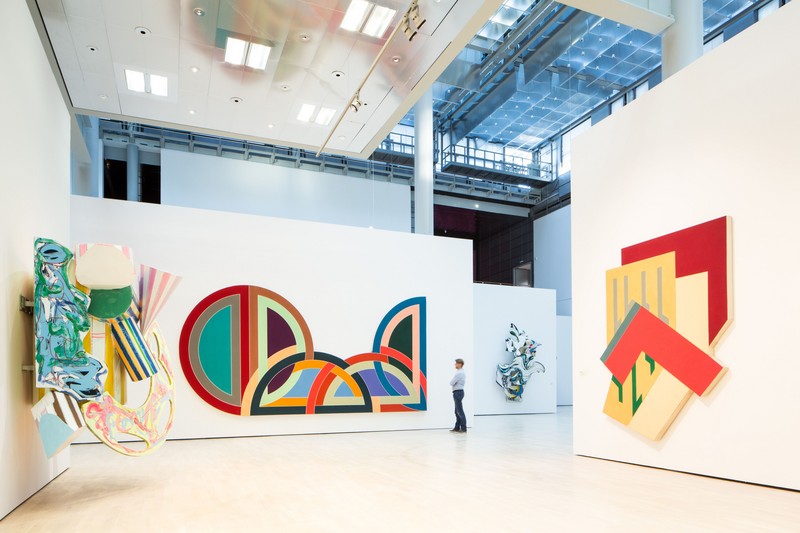
Frank Stella – The Retrospective. Works 1958-2012
Installation view at Kunstmuseum Wolfsburg 2012
From left to right: Bene come il sale, 1987, Mixed media on aluminum, 238 x 227 x 157 cm, Sammlung
Henkel. Isfahan, 1969, Oil on canvas, 305 × 612 × 7.5 cm, Sammlung Henkel. The Grand Armada (IRS,
No. 6, 1X) , 1989, Painted aluminum relief, 315 x 186.5 x 99 cm, Fondation Beyeler, Riehen/Basel.
Dawidgrodek II, 1971, Acrylic on canvas on wooden frame, 274 × 208.5 × 9.3 cm, LehmbruckMuseum,
Duisburg.
© VG Bild-Kunst Bonn, 2012, Photo: Marek Kruszewski
Installation view at Kunstmuseum Wolfsburg 2012
From left to right: Bene come il sale, 1987, Mixed media on aluminum, 238 x 227 x 157 cm, Sammlung
Henkel. Isfahan, 1969, Oil on canvas, 305 × 612 × 7.5 cm, Sammlung Henkel. The Grand Armada (IRS,
No. 6, 1X) , 1989, Painted aluminum relief, 315 x 186.5 x 99 cm, Fondation Beyeler, Riehen/Basel.
Dawidgrodek II, 1971, Acrylic on canvas on wooden frame, 274 × 208.5 × 9.3 cm, LehmbruckMuseum,
Duisburg.
© VG Bild-Kunst Bonn, 2012, Photo: Marek Kruszewski
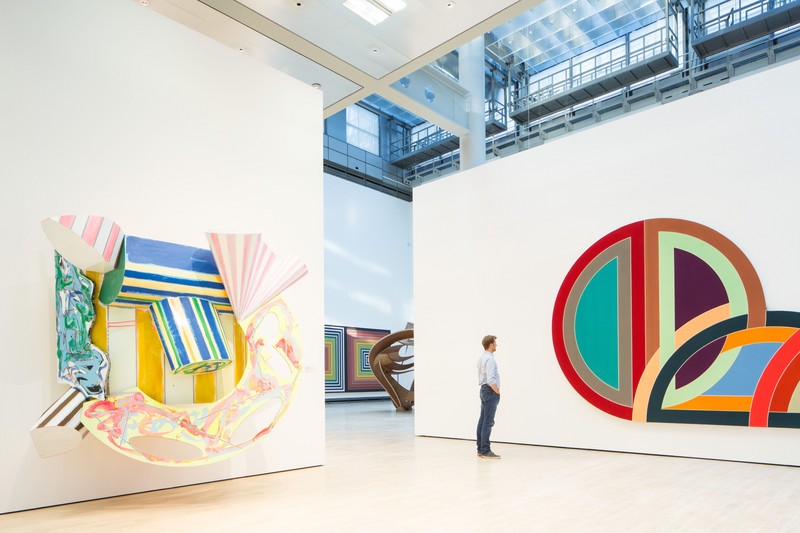
Frank Stella – The Retrospective. Works 1958-2012
Installation view at Kunstmuseum Wolfsburg 2012
Bene come il sale, 1987, Mixed media on aluminum, 238 x 227 x 157 cm, Sammlung Henkel.
Paradoxe sur le comediene, 1974, Synthetic polymer paint on canvas, 360.7 × 721.4 cm, Collection of the
artist. The Broken Jug: A Comedy [D#3] (left-handed version), 2007, Marine ply and pine, 475 × 515 × 360
cm, Collection of the artist. Isfahan, 1969, Oil on canvas, 305 × 612 × 7.5 cm, Sammlung Henkel.
© VG Bild-Kunst Bonn, 2012, Photo: Marek Kruszewski
Installation view at Kunstmuseum Wolfsburg 2012
Bene come il sale, 1987, Mixed media on aluminum, 238 x 227 x 157 cm, Sammlung Henkel.
Paradoxe sur le comediene, 1974, Synthetic polymer paint on canvas, 360.7 × 721.4 cm, Collection of the
artist. The Broken Jug: A Comedy [D#3] (left-handed version), 2007, Marine ply and pine, 475 × 515 × 360
cm, Collection of the artist. Isfahan, 1969, Oil on canvas, 305 × 612 × 7.5 cm, Sammlung Henkel.
© VG Bild-Kunst Bonn, 2012, Photo: Marek Kruszewski
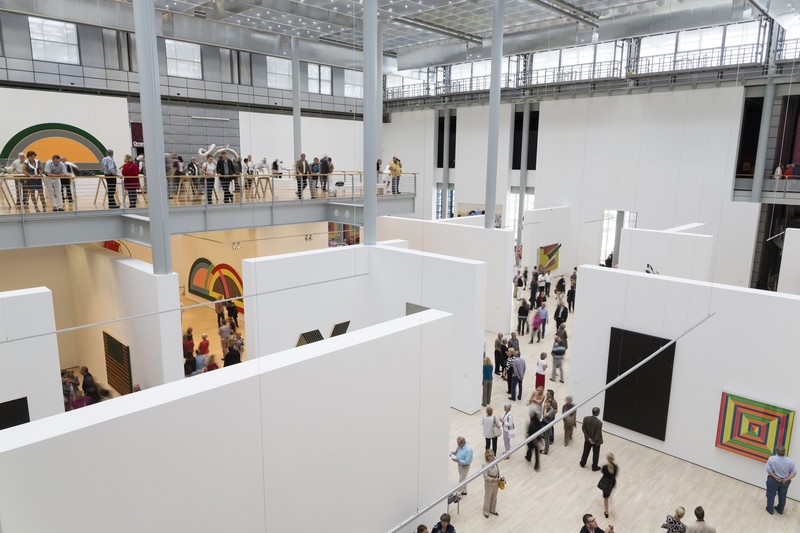
Frank Stella – The Retrospective. Works 1958-2012
Installation view at Kunstmuseum Wolfsburg 2012
© VG Bild-Kunst, Bonn 2012, Foto: Marek Kruszewski
Installation view at Kunstmuseum Wolfsburg 2012
© VG Bild-Kunst, Bonn 2012, Foto: Marek Kruszewski
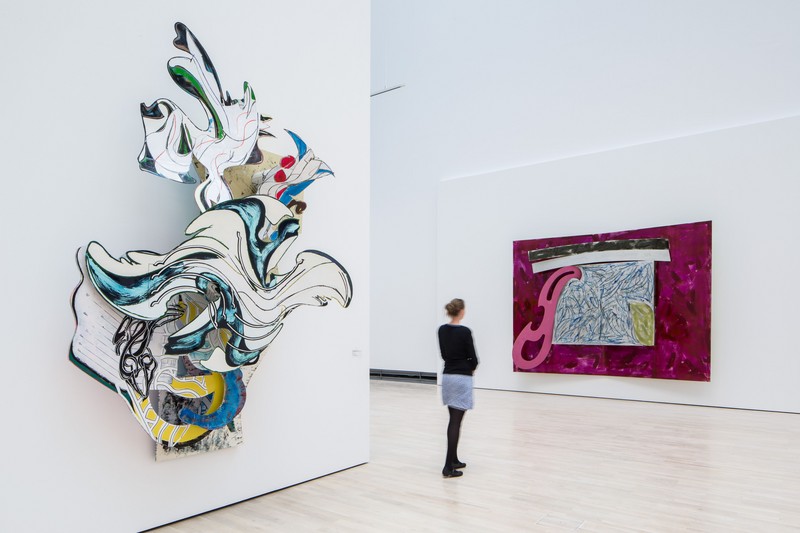
Installationview Frank Stella – The Retrospective. Works 1958-2012 (08.09.2012 – 20.01.2013),
Kunstmuseum Wolfsburg.
Left: The Grand Armada (IRS, No. 6, 1X) , 1989, Painted aluminum relief, 315 x 186.5 x 99 cm, Fondation
Beyeler, Riehen/Basel. Right: Mysterious Bird of Ulieta I, 1976, Enamel, oil, and glass on aluminum, 300
× 400 × 60 cm, Staatsgalerie Stuttgart.
© VG Bild-Kunst Bonn, 2012, Photo: Marek Kruszewski
Kunstmuseum Wolfsburg.
Left: The Grand Armada (IRS, No. 6, 1X) , 1989, Painted aluminum relief, 315 x 186.5 x 99 cm, Fondation
Beyeler, Riehen/Basel. Right: Mysterious Bird of Ulieta I, 1976, Enamel, oil, and glass on aluminum, 300
× 400 × 60 cm, Staatsgalerie Stuttgart.
© VG Bild-Kunst Bonn, 2012, Photo: Marek Kruszewski
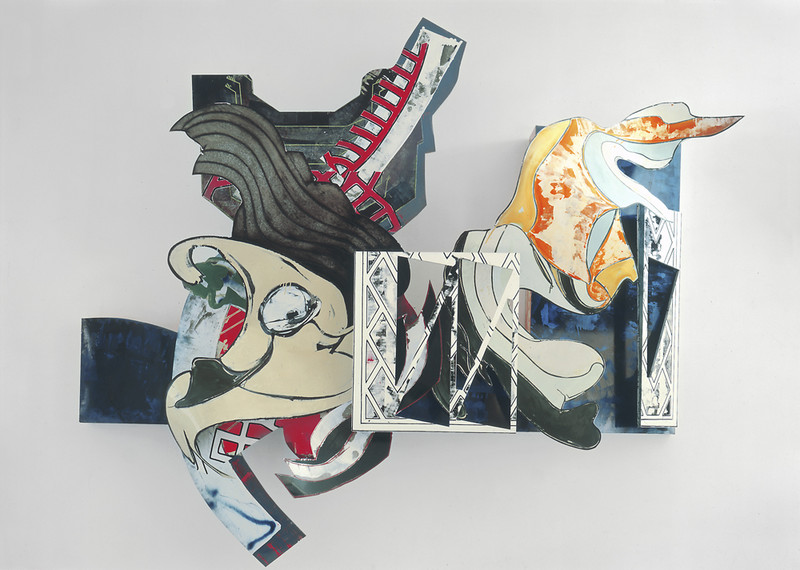
Frank Stella
Measurement of the Whale's Skeleton, 1988
Mixed media on aluminum
426 x 485 x 47 cm
SCHAUWERK Sindelfingen
© VG Bild-Kunst, Bonn 2012
Measurement of the Whale's Skeleton, 1988
Mixed media on aluminum
426 x 485 x 47 cm
SCHAUWERK Sindelfingen
© VG Bild-Kunst, Bonn 2012

Frank Stella – The Retrospective. Works 1958-2012
Installation view at Kunstmuseum Wolfsburg 2012
Six Mile Bottom, 1960, Aluminum oil paint on canvas, 300 × 182.2 × 7.5 cm, Tate: Purchased
1972. La vecchia dell’orto, 1986, Acrylic, enamel, and fluorescent alkyd on aluminum, 323 × 388 × 106
cm, Centre Pompidou, Paris, Musée national d’art moderne / Centre de création industrielle, Don de
Michel et Hélène David-Weill, grâce à la Georges Pompidou Art and Culture Foundation en l'honneur de
Dominique Bozo, 1986, Inv. No. AM 1986-252, Fig. pp. 226–27. The Grand Armada (IRS, No. 6, 1X) ,
1989, Painted aluminum relief, 315 x 186.5 x 99 cm, Fondation Beyeler, Riehen/Basel. Tuxedo Junction,
1960, Enamel on canvas, 310 × 185 × 7 cm, Van Abbemuseum Collection, Eindhoven, Netherlands,
© VG Bild-Kunst Bonn, 2012, Photo: Marek Kruszewski
Installation view at Kunstmuseum Wolfsburg 2012
Six Mile Bottom, 1960, Aluminum oil paint on canvas, 300 × 182.2 × 7.5 cm, Tate: Purchased
1972. La vecchia dell’orto, 1986, Acrylic, enamel, and fluorescent alkyd on aluminum, 323 × 388 × 106
cm, Centre Pompidou, Paris, Musée national d’art moderne / Centre de création industrielle, Don de
Michel et Hélène David-Weill, grâce à la Georges Pompidou Art and Culture Foundation en l'honneur de
Dominique Bozo, 1986, Inv. No. AM 1986-252, Fig. pp. 226–27. The Grand Armada (IRS, No. 6, 1X) ,
1989, Painted aluminum relief, 315 x 186.5 x 99 cm, Fondation Beyeler, Riehen/Basel. Tuxedo Junction,
1960, Enamel on canvas, 310 × 185 × 7 cm, Van Abbemuseum Collection, Eindhoven, Netherlands,
© VG Bild-Kunst Bonn, 2012, Photo: Marek Kruszewski
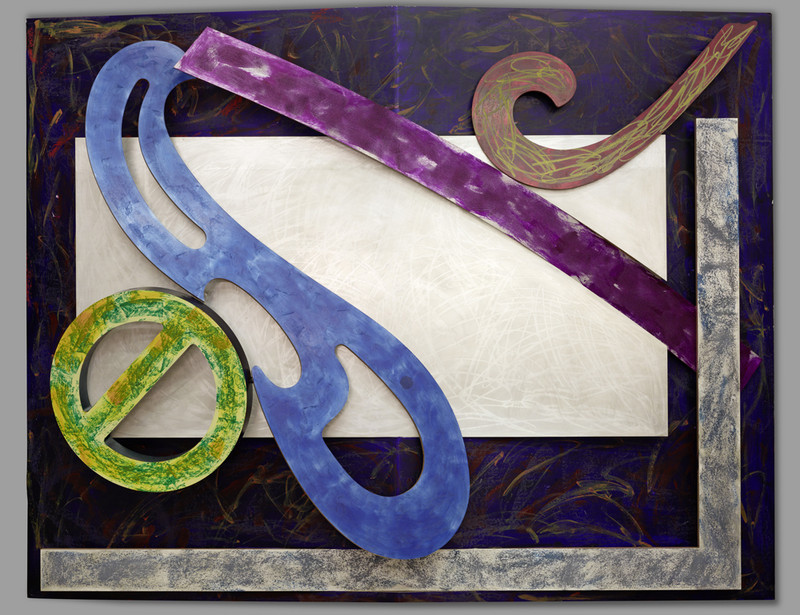
Frank Stella
Bonin Night Heron I , 1976
Acrylic on aluminium
275 x 350 x 65 cm
Museum Ludwig, Cologne/Peter and Irene Ludwig Foundation
Photo: © Rheinisches Bildarchiv Cologne, rba_d031385
© VG Bild-Kunst, Bonn 2012
Bonin Night Heron I , 1976
Acrylic on aluminium
275 x 350 x 65 cm
Museum Ludwig, Cologne/Peter and Irene Ludwig Foundation
Photo: © Rheinisches Bildarchiv Cologne, rba_d031385
© VG Bild-Kunst, Bonn 2012
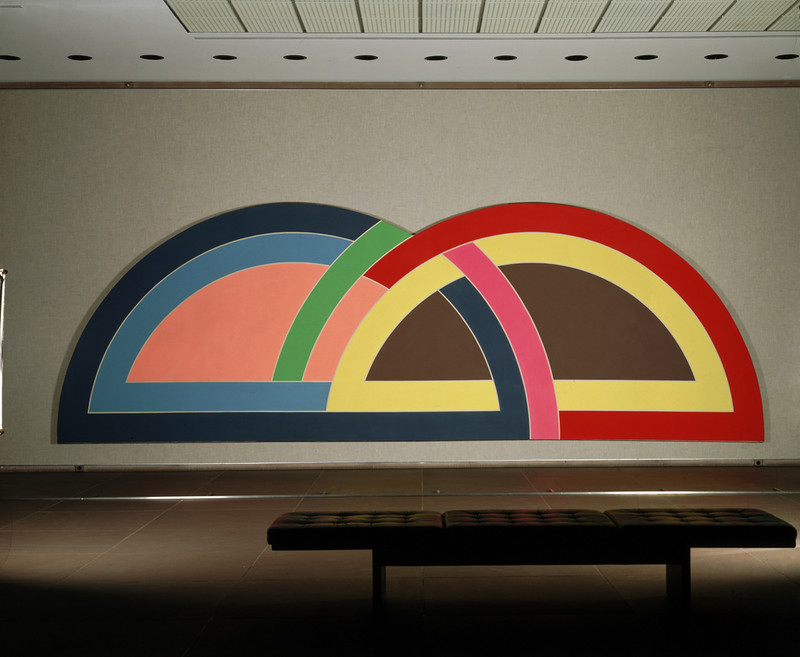
Frank Stella
Khurasan Gate I, 1968
Acrylic on canvas
240 x 720 x 10 cm
Kunsthalle Bielefeld
Photo: von Uslar, Bielefeld
© VG Bild-Kunst, Bonn 2012
Khurasan Gate I, 1968
Acrylic on canvas
240 x 720 x 10 cm
Kunsthalle Bielefeld
Photo: von Uslar, Bielefeld
© VG Bild-Kunst, Bonn 2012

Frank Stella
Ifafa II, 1964
Metallic powder and acrylic on canvas
197 × 331.5 × 7.5 cm
Kunstmuseum Basel
Photo: Martin P. Bühler, Kunstmuseum Basel
© VG Bild-Kunst, Bonn 2012
Ifafa II, 1964
Metallic powder and acrylic on canvas
197 × 331.5 × 7.5 cm
Kunstmuseum Basel
Photo: Martin P. Bühler, Kunstmuseum Basel
© VG Bild-Kunst, Bonn 2012
FRANK STELLA
The Retrospective. Works 1958-2012
8 September 2012 – 20 January 2013
Frank Stella (born 1936) is one of the last living heroes of American painting from the 1950s and 1960s, the time when American art found its way to its own identity, reaching its historic zenith in the process. His artistic creativeness is still unbroken today. At the age of only twenty, Stella conquered the New York art scene with a sensation in 1959: His large Black Paintings not only intensified the discussion concerning Minimalism in painting but also prepared the ways for the “exit from the picture into the space.” Unlike his contemporaries, Frank Stella subsequently went his own way, taking a path that led him to ever more opulent, ever more baroque reliefs. With his turn “from Minimalism to Maximalist,” Frank Stella developed into one of the most distinctive artists of the 20th century. The Kunstmuseum Wolfsburg is now dedicating a comprehensive retrospective to him encompassing 63 largeformat works and 82 works on paper, the most comprehensive to be seen anywhere in the world for over 15 years. In historical and in formal terms, Frank Stella’s work forms the bridge spanning the heroic era of monochromatic color field painting—for example that of a Barnett Newman—and abstraction in the 21st century. He simultaneously crowned and renewed abstract art.
In this most comprehensive exhibition to be seen anywhere in the world since 1995, the Kunstmuseum Wolfsburg shows the “whole Stella.” A wide-ranging staging has been developed in cooperation with the artist where the impact of the individual works can unfold anew and moreover enter into an exciting interaction with each other. The diversity of these dialogues between color, form and space thus becomes tangible and comprehensible throughout the exhibition. But the representative selection of works made together with the artist also provides intense insights into the development of an oeuvre spanning over 50 very productive years. It traces the successive conquering of space to the visionary and most recent works, anticipating in the process the basic elements of fractal and digital aesthetics. With the exception of the opening section of the exhibition, the presentation is not strictly chronological – later works suddenly appear in earlier contexts and vice versa. Im this way insights are provided into the artist’s working method and the ties between his various series are visualized. Frank Stella experimented with ever newer technical means in order to realize his artistic innovations. He was thus one of the first artists to prepare his works with the help of the computer. These constantly visionary designs are also reflected in his architectonic plans that are on show on the gallery. At the conclusion of the exhibition, a room with Stella’s early sketches provides insights into the genesis of his works.
The Kunstmuseum Wolfsburg places Stella’s oeuvre for the first time in a larger art historical context that extends far beyond modernism. The exhibition is not only concern with a depiction of his oeuvre in its entirety but also with its grounding in history and its function as a bride builder to the 21st century. This also includes the question concerning the role of the ornament and the future of abstraction. To this end a separate exhibition with ornamental prints from the 15th to 18th centuries – from Dürer to Piranesi – has been set up on the upper floor of the museum. It was opened in May and runs almost exactly parallel to the Stella exhibition (to January 6, 2013). A cabinet with a selection of work drawings presented by the artist to the Kunstmuseum Basel in 1980 forms the transition to this historical exhibition. Not only is the unbroken currency of the ornamental evident in this look back at pre-modernist art, especially in contemporary art, but the parallelism to the exhibition in the main hall enables the abstraction to be comprehended in a much larger context and suggests that the history of abstraction merges with that of the ornament in Frank Stella’s work.
The exhibition includes such key works as the Black Paintings, Damascus Gate (1969–70), works from the Polish Village and the Irregular Polygon Series, La penna di hu (‚19, 3D, 3x) (1987–2009), Etymology (Q-10) (1990) and The Broken Jug. A Comedy [D#3] (left handed version) (2007). K.179 (2011) from the Scarlatti Sonata Kirkpatrick Series was made for the Wolfsburg exhibition and is being shown publically here for the first time. These and the other works have for example been made available by the Kunstmuseum Basel, Tate London, the Museum Ludwig Cologne, the VanAbbemuseum Eindhoven as well as the Henkel Collection Düsseldorf, the Hoffmann Collection Berlin and finally by Frank Stella himself.
The Retrospective. Works 1958-2012
8 September 2012 – 20 January 2013
Frank Stella (born 1936) is one of the last living heroes of American painting from the 1950s and 1960s, the time when American art found its way to its own identity, reaching its historic zenith in the process. His artistic creativeness is still unbroken today. At the age of only twenty, Stella conquered the New York art scene with a sensation in 1959: His large Black Paintings not only intensified the discussion concerning Minimalism in painting but also prepared the ways for the “exit from the picture into the space.” Unlike his contemporaries, Frank Stella subsequently went his own way, taking a path that led him to ever more opulent, ever more baroque reliefs. With his turn “from Minimalism to Maximalist,” Frank Stella developed into one of the most distinctive artists of the 20th century. The Kunstmuseum Wolfsburg is now dedicating a comprehensive retrospective to him encompassing 63 largeformat works and 82 works on paper, the most comprehensive to be seen anywhere in the world for over 15 years. In historical and in formal terms, Frank Stella’s work forms the bridge spanning the heroic era of monochromatic color field painting—for example that of a Barnett Newman—and abstraction in the 21st century. He simultaneously crowned and renewed abstract art.
In this most comprehensive exhibition to be seen anywhere in the world since 1995, the Kunstmuseum Wolfsburg shows the “whole Stella.” A wide-ranging staging has been developed in cooperation with the artist where the impact of the individual works can unfold anew and moreover enter into an exciting interaction with each other. The diversity of these dialogues between color, form and space thus becomes tangible and comprehensible throughout the exhibition. But the representative selection of works made together with the artist also provides intense insights into the development of an oeuvre spanning over 50 very productive years. It traces the successive conquering of space to the visionary and most recent works, anticipating in the process the basic elements of fractal and digital aesthetics. With the exception of the opening section of the exhibition, the presentation is not strictly chronological – later works suddenly appear in earlier contexts and vice versa. Im this way insights are provided into the artist’s working method and the ties between his various series are visualized. Frank Stella experimented with ever newer technical means in order to realize his artistic innovations. He was thus one of the first artists to prepare his works with the help of the computer. These constantly visionary designs are also reflected in his architectonic plans that are on show on the gallery. At the conclusion of the exhibition, a room with Stella’s early sketches provides insights into the genesis of his works.
The Kunstmuseum Wolfsburg places Stella’s oeuvre for the first time in a larger art historical context that extends far beyond modernism. The exhibition is not only concern with a depiction of his oeuvre in its entirety but also with its grounding in history and its function as a bride builder to the 21st century. This also includes the question concerning the role of the ornament and the future of abstraction. To this end a separate exhibition with ornamental prints from the 15th to 18th centuries – from Dürer to Piranesi – has been set up on the upper floor of the museum. It was opened in May and runs almost exactly parallel to the Stella exhibition (to January 6, 2013). A cabinet with a selection of work drawings presented by the artist to the Kunstmuseum Basel in 1980 forms the transition to this historical exhibition. Not only is the unbroken currency of the ornamental evident in this look back at pre-modernist art, especially in contemporary art, but the parallelism to the exhibition in the main hall enables the abstraction to be comprehended in a much larger context and suggests that the history of abstraction merges with that of the ornament in Frank Stella’s work.
The exhibition includes such key works as the Black Paintings, Damascus Gate (1969–70), works from the Polish Village and the Irregular Polygon Series, La penna di hu (‚19, 3D, 3x) (1987–2009), Etymology (Q-10) (1990) and The Broken Jug. A Comedy [D#3] (left handed version) (2007). K.179 (2011) from the Scarlatti Sonata Kirkpatrick Series was made for the Wolfsburg exhibition and is being shown publically here for the first time. These and the other works have for example been made available by the Kunstmuseum Basel, Tate London, the Museum Ludwig Cologne, the VanAbbemuseum Eindhoven as well as the Henkel Collection Düsseldorf, the Hoffmann Collection Berlin and finally by Frank Stella himself.

